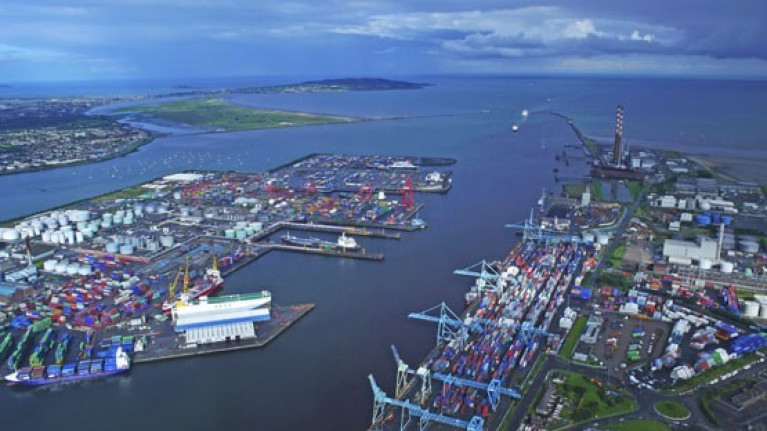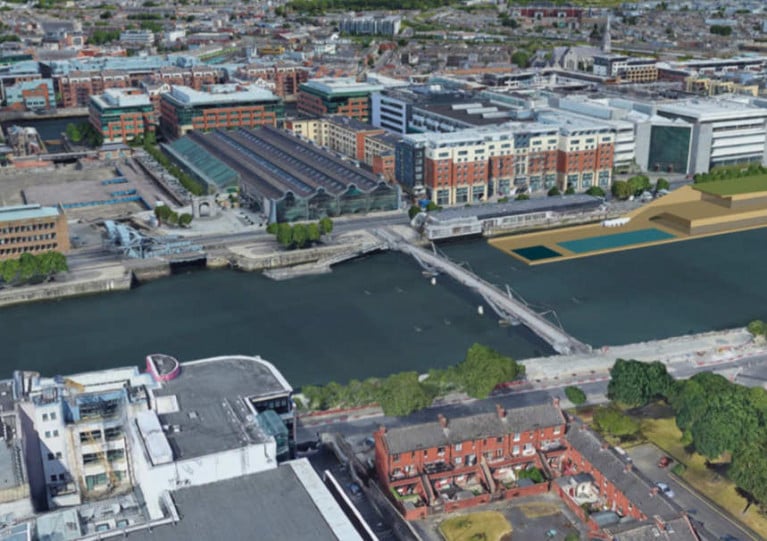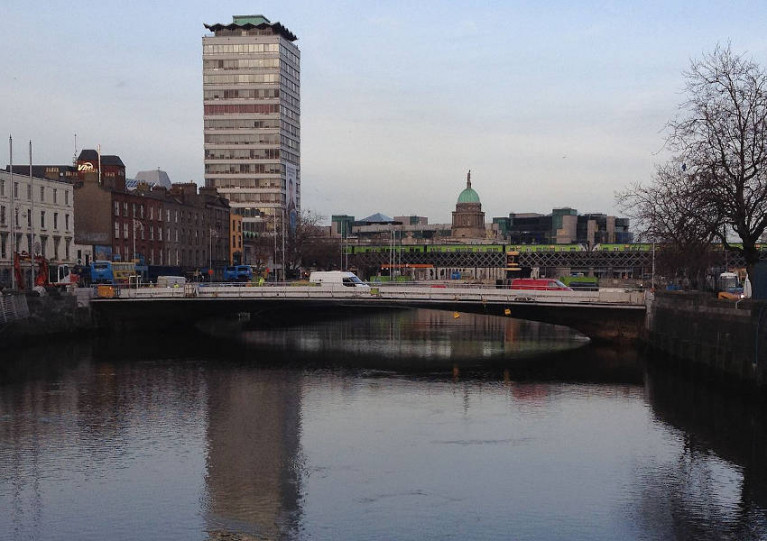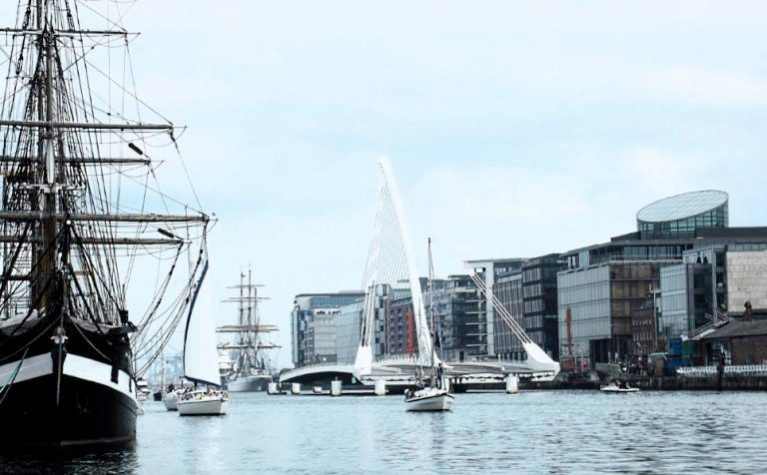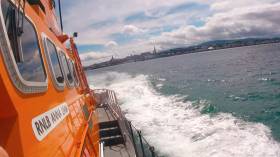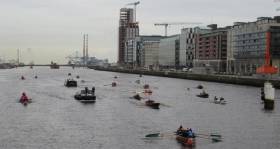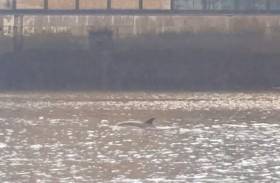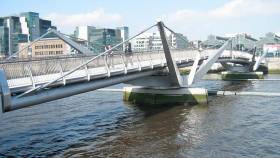Displaying items by tag: River Liffey
Two men who were jailed earlier this year for drunkenly sailing their boat up the River Liffey from Dublin Port will have a hearing of their appeal to overturn the verdict and sentences next April, as TheJournal.ie reports.
Boat owner Brian Stacey (46) and Ronan Stephens (43), both from Crumlin, were each sentenced to three months in prison with the final month suspended over the incident on 1 June 2017.
Afloat.ie previously reported on the early morning chase up the River Liffey from the port to Sir John Rogerson’s Quay.
The court heard that the skipper’s erratic driving of the 26ft quarter tonner Peja delayed the entry of the 4,000-tonne cruise liner Corinthian into the port.
It was also heard that Stephens was arrested after he made landfall at the city quays and stripped off his clothes, and told gardaí he had a “God-given right to operate on the water”.
TheJournal.ie has more on the story HERE.
A site on Custom House Quay adjacent to the planned white water rafting course in George’s Dock has been earmarked for a €15 million outdoor pool, as TheJournal.ie reports.
The scheme being proposed by Dublin City Council is modelled after a similar facility in Helsinki, Finland — complete with a pool floating on the River Liffey and saunas in an adjacent quayside complex.
It also appears superficially similar to the ‘urban beach’ project that was proposed for Dun Laoghaire, in the vein of Berlin’s Badeschiff, but was put on hold a number of years ago over funding issues within the former Dun Laoghaire Harbour Company.
Custom House Quay was chosen as the optimum site for the project as its proximity to the controversial rafting course would help develop the area “into a hub for water based recreational activity in the city”, says Docklands area manager Derek Kelly.
TheJournal.ie has more on the story HERE.
Fire Brigade Rescues Three From River Liffey
BreakingNews.ie reports that three people have been rescued from the River Liffey by the fire brigade in Dublin city centre this afternoon (Monday 24 February).
It’s understood that two of the individuals jumped into the water to save the first who was since hospitalised following in the incident, between O’Connell Bridge and Butt Bridge at 11.45am.
Yachtsman Found Guilty Of Sailing While Drunk In Dublin Port Incident
The captain of a small sailing boat has been found guilty of operating a vessel while intoxicated, among a number of charges over an incident during the Dublin Port Riverfest in 2017.
Boat owner Brian Stacey (46) and Ronan Stephens (42), both from Crumlin, went on trial last summer over the incident on 1 June 2017 that prompted an early morning chase up the River Liffey from Dublin Port to Sir John Rogerson’s Quay.
The court heard that the skipper’s erratic driving of the 26ft quarter tonner Peja delayed the entry of the 4,000-tonne cruise liner Corinthian into the port.
Stephens was arrested after he made landfall at the city quays and stripped off his clothes, it was heard.
And the court also heard Stacey say it was his “God-given right to operate on the water” as he and his co-accused denied all charges, insisting there was no alcohol on their vessel.
Both will be sentenced next week. RTÉ News has much more on the story HERE.
A small sailing boat that was “erratically” zigzagging in the shipping lane delayed a cruise liner from entering Dublin Port, as the Irish Independent reports from a Dublin court.
The trial of two Crumlin men facing charges under the Maritime Safety Act and the Public Order Act is currently before Dublin District Court, following the incident on 1 June 2017 ahead of that year’s Dublin Port Riverfest.
As previously reported on Afloat.ie, Brian Stacey and Ronan Stephens were charged over the incident that prompted an early-morning chase up the River Liffey as far as Sir John Rogerson’s Quay.
It’s also claimed that the activity delayed the entry of the 4,000-tonne cruise liner Corinthian into the port.
The trial continues on Tuesday 18 June. Independent.ie has much more on the story HERE.
On RTE One Tonight: New Documentary 'Starboard Home'
A new documentary 'Starboard Home' (on RTE One tonight at 10.15pm) which formed part of the 1916 Easter Rising centenary commemorations held in Dublin, involved musicians commissioned to produce works inspired by the capital, its port and the Liffey.
In a rare musicial opportunity, Dublin Port and the National Concert Hall invited Irish musicians to respond to the theme resulting to an acclaimed modern song cycle that rekindles the formative bond between the city and Dublin Bay through music, song and the spoken word.
Among musicians lined up for the unique commemorative event were James Vincent McMarrow and Gemma Hayes.
In conjunction with tonight's broadcast, Moira Sweeney’s film ‘Keepers of the Port’ will be airing on RTÉ’s Culture website.
So keep a look-out! for the Starboard Home documentary which is one not to be missed!
Mammoth Eight-Hour Rowing Challenge On River Liffey Will Raise Funds For Charities
All In A Row 2018 comes to the River Liffey this Saturday 1 December, challenging teams rowing 40 skiffs, kayaks, canoes and currachs to exceed a 1,000km target in eight hours.
The organisers are hoping to beat last year’s target during the event from St Patrick’s Rowing Club at the Tom Clarke Bridge (formerly the East-Link Bridge) and finishing at the Ha’penny Bridge.
While showcasing the River Liffey as one of Dublin’s best amenities, the challenge also aims to raise funds for water-related charities, namely the RNLI and the Irish Underwater Search and Recovery Unit.
The event will start at 8am this Saturday and at noon all boats will gather in front of the Sean O’Casey footbridge. A wreath-laying ceremony, attended by the Lord Mayor of Dublin Nial Ring, will also take place to commemorate all those who have lost their lives through drowning.
The event remembers particularly the crew of the currach rowed and sailed from the Liffey to Santiago de Compostela and who later lost a valued crew member in Danny Sheehy.
The RNLI will have an Atlantic 85 inshore lifeboat on display for people to view during the day, berthed alongside the Jeanie Johnston replica famine ship.
The event is also being used as an opportunity to engage with inner city Dublin schools whose pupils have been invited to the Dublin Docklands offices to learn about water safety through the RNLI’s Respect the Water campaign, and how they can volunteer in their communities to help save lives at sea. The city’s Sea Scouts will also be participating in the event.
Many Dublin rowing clubs have their home on the River Liffey and are a regular sight on the water. At the port end of the river is St Patrick’s Rowing Club, Stella Maris Rowing Club, East Wall Water Sports Group and Poolbeg Yacht and Boat Club.
Ringsend Basin is home to the Plurabelle Paddlers (Dragon boats) and the Dublin Viking Dragon boat club. At the other end of the city, beyond Heuston Station, there are many river rowing clubs and kayaking clubs, including Phoenix Rowing Club.
This Saturday the many boating clubs of the Liffey will be joined by rowing clubs from other parts of Ireland.
“Everyone knows the River Liffey but most people don’t know how far it stretches and how many rowing groups use it regularly,” organisers said.
“There is a vibrant boating community on the River Liffey and these clubs regard it as the living artery of the city and one of Dublin’s great and undervalued amenities.
“After the beautiful summer we’ve had, we know that people are drawn to the water, whether on the coast or inland to enjoy different water sports.
“The Liffey is an undervalued and underused resource that is right under people’s noses and we want to encourage them to use it and to use it safely. From school children right up to seasoned rowers, this is a great opportunity to draw people down to the Liffey and learn about water safety and the fun activities they can do on the water all year round.”
Competitors are asked to raise sponsorship for the event, and for those not competing and supporters, there is a GoFundMe page for donations.
Common Dolphin In River Liffey Brightens A Dreary Day For Dubliners
A dreary, stormy day in Dublin city centre was brightened with the appearance of a common dolphin swimming up the River Liffey as far as the Loopline Bridge.
The Irish Whale and Dolphin Group (IWDG) says it got its first reports early this morning (Wednesday 28 November) from the Jeanie Johnston, whose John O’Neill shot this video of the solo cetacean swimming loops in the river.
It was spotted swimming strongly as far west as Liberty Hall around lunchtime before heading back east and towards Dublin Bay.
Dolphins are known to develop kidney and skin problems on prolonged exposure to freshwater environments such as rivers.
However, the IWDG moved to assuage public concerns over this particular animal — saying that if it was swimming as strongly as sightings suggested, it would be more than able to swim back to sea.
It’s suggested that this short-beaked visitor may be one of a pod of some 20 dolphins known to be feeding off the East Coast this month.
Liffey Bridges Lift For End-Of-Season Cruising Rally This Saturday
#Cruising - The Cruising Association of Ireland brings a successful 2018 to a close with their annual Three Bridges Rally in the River Liffey in Dublin city centre this Saturday 15 September.
Supported by Dublin Port and Dublin City Council, the event will see all three Liffey spans east of the Talbot Memorial Bridge — namely the Sean O’Casey, Samuel Beckett and East-Link — lift at 3pm on Saturday for the 30 or more yachts to sail upriver as far as the Custom House.
After a circuit of the Liffey, the boats will berth at the Dublin Port pontoon, near Point Village, which has been extended to 200 meters to accommodate the rally. The port will also host a Commodore’s reception with fine dining and entertainment that evening.
However, cruisers shouldn’t party too hard, as lines will slip early on Sunday at 11am when the East Link opens to let the passenger ship St Brigid into Dublin Bay.
This summer the CAI — a group of more than 120 cruising sailors who organise events and support each other’s adventures — conducted rallies to the Clyde in Scotland, Malahide and Greystones, and some yachts have spent a month or more cruising extensively. For more visit www.cruising.ie.
Young Kayakers Set For Tomorrow’s Junior Liffey Descent
#Kayaking - The Irish Times has a preview of Ireland’s largest junior kayaking race — and one of the biggest events in some time for Canoeing Ireland — which takes place on the River Liffey tomorrow (Saturday 19 May).
The Junior Liffey Descent is set to bring more than 160 young paddlers to Leixlip for racing to Strawberry Beds across 19 categories in four boat classes tomorrow afternoon.


























